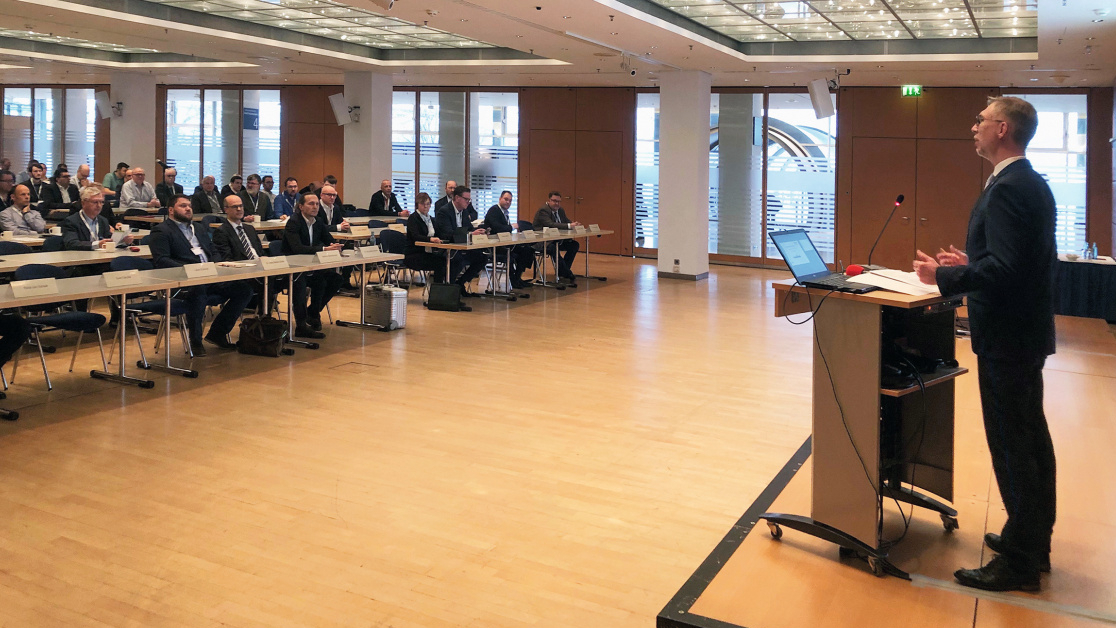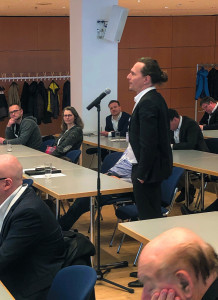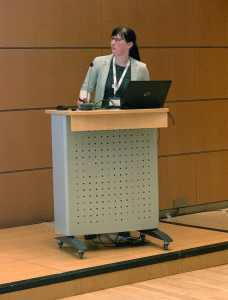This year, the now second-largest DGO event kicked off for the 28th time on March 9 in Leipzig. Looking back, the Leipzig specialist seminar is a success story about a regional event that has developed into a nationwide industry event. This year's program included REACh, brake coatings and the electroplating of textiles.
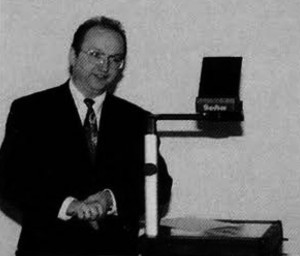 In 1997, Mr. Spielvogel from the DGO Leipzig/Halle district group illustrated his presentation with an overhead projector instead of using a projector as is common today (Photo: DGO)The Leipzig specialist seminar has developed into a traditional industry event over the past few decades. It was launched in 1994 by the regional district groups of the German Society for Surface Technology (DGO) as a platform for electroplating and surface technology in the new federal states. If you search the archives of Galvanotechnik magazine, you will find a detailed report on the event for the first time in 1997 - written by Marion Regal from the DGO in Saxony, who is still active in the DGO today and also contributed to this conference report. In 1997, the focus was less on the now omnipresent REACh topic, but certainly on cleaning and wastewater issues, which are still on the agenda. At that time, the attendance of 98 participants was considered good, and 15 companies also presented themselves on the fringes of the event. And this clearly shows the difference to today and the heyday of the specialist seminar before the corona pandemic, because interest in the Leipzig specialist seminar has grown continuously since the 1990s: in the years before corona, participation fluctuated between 260 and 280 participants and 50 to 60 exhibiting companies at the trade exhibition - the specialist seminar was thus three to four times as popular as in the early years of the post-reunification period.
In 1997, Mr. Spielvogel from the DGO Leipzig/Halle district group illustrated his presentation with an overhead projector instead of using a projector as is common today (Photo: DGO)The Leipzig specialist seminar has developed into a traditional industry event over the past few decades. It was launched in 1994 by the regional district groups of the German Society for Surface Technology (DGO) as a platform for electroplating and surface technology in the new federal states. If you search the archives of Galvanotechnik magazine, you will find a detailed report on the event for the first time in 1997 - written by Marion Regal from the DGO in Saxony, who is still active in the DGO today and also contributed to this conference report. In 1997, the focus was less on the now omnipresent REACh topic, but certainly on cleaning and wastewater issues, which are still on the agenda. At that time, the attendance of 98 participants was considered good, and 15 companies also presented themselves on the fringes of the event. And this clearly shows the difference to today and the heyday of the specialist seminar before the corona pandemic, because interest in the Leipzig specialist seminar has grown continuously since the 1990s: in the years before corona, participation fluctuated between 260 and 280 participants and 50 to 60 exhibiting companies at the trade exhibition - the specialist seminar was thus three to four times as popular as in the early years of the post-reunification period.
Strengthening of the industry expected
The aim was to reach this benchmark three years later - which was almost achieved: with 220 participants and 42 companies, the post-corona debut followed on quite well from the last face-to-face event in 2020. The industry event was held at the Congress Center Leipzig right next to the Leipzig exhibition grounds. This year, the industry and supplier trade fairs Intech, Grindtech and Z took place alongside the event, which was well received by the participants.
Prof. Thomas Lampke, moderator of the morning program and head of the Chair of Materials and Surface Technology at Chemnitz University of Technology, gave the introductory speech. He started with a look at the date March 9 in the course of history and recalled the announcement of the development of the first electron microscope on this day in 1931. Ernst Muska was later awarded the Nobel Prize in Physics for this development. Prof. Lampke also mentioned the Bundestag's decision to introduce the retirement age of 67 in 2007 and paid tribute to the Austrian-German composer Hanns Eisler, who was born in Leipzig 125 years ago and composed the music for Brecht's Threepenny Opera, among other works. After Prof. Lampke, DGO Chairman Dr. Martin Metzner took to the lectern. He pointed out that the annual event has long been more of a congress than a specialist seminar due to the high number of participants. In his speech, Dr. Metzner quickly made the connection to the current transformation of industry, the economy and society and spoke of exciting technical times. The shift towards electromobility will lead to some coatings becoming obsolete. However, the hydrogen economy offers potential for electrochemistry and electroplating. In proton exchange membrane (PEM) electrolysers, the current beacon of hope for decentralized hydrogen production, however, the iridium required for coating the electrodes of electrolysers is four hundred times rarer than gold, which is why the development of nanolayers, new alloys, selective coating processes and recovery processes is important, he concluded. "The industry will look different in 10-20 years, but will probably be stronger," was Dr. Metzner's confident outlook at the end of his speech. The last speaker before the lecture program was Messe Leipzig Managing Director Markus Geisenberger, who praised the Leipzig trade seminar as an important focal event for electroplating and surface technology.
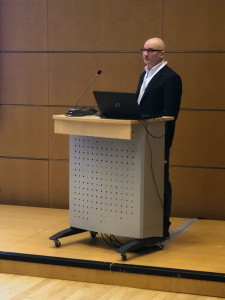 Arcadius Waleska from WHW Hillebrand represented Malte Zimmer and brought the participants up to date on the topic of REACh
Arcadius Waleska from WHW Hillebrand represented Malte Zimmer and brought the participants up to date on the topic of REACh
Morning program under the sign of industrial transformation
 In terms of topics, the specialist seminar immediately addressed the most sensitive current issue in surface technology: REACh and Cr(VI) in Europe. Malte Zimmer, the new President of CETS (European Committee for Surface Treatment), was originally scheduled to speak on this topic. However, a court case concerning the documentation of chromium trioxide as an intermediate product, according to Arcadius Waleska, WHW Hillebrand, prevented the environmental and chemicals policy expert from appearing in Leipzig. Waleska described the current status of authorizations and which applications they affect. He also addressed the so-called "essential use concept", i.e. the continued indispensable use of chemicals, and showed under which circumstances there can still be exemptions. However, according to Waleska, ECHA is increasingly focusing on the substitution of harmful chemicals. The basic idea behind the European chemicals policy with the European Green Deal was to strengthen the German and European economy, Walesa said, citing declarations of intent made by politicians in the past, and concluded with the critical words: "But what is happening? BASF jobs are moving to China!"
In terms of topics, the specialist seminar immediately addressed the most sensitive current issue in surface technology: REACh and Cr(VI) in Europe. Malte Zimmer, the new President of CETS (European Committee for Surface Treatment), was originally scheduled to speak on this topic. However, a court case concerning the documentation of chromium trioxide as an intermediate product, according to Arcadius Waleska, WHW Hillebrand, prevented the environmental and chemicals policy expert from appearing in Leipzig. Waleska described the current status of authorizations and which applications they affect. He also addressed the so-called "essential use concept", i.e. the continued indispensable use of chemicals, and showed under which circumstances there can still be exemptions. However, according to Waleska, ECHA is increasingly focusing on the substitution of harmful chemicals. The basic idea behind the European chemicals policy with the European Green Deal was to strengthen the German and European economy, Walesa said, citing declarations of intent made by politicians in the past, and concluded with the critical words: "But what is happening? BASF jobs are moving to China!"
In the second presentation, Erik Bratfisch from bi.bra Abwassertechnik GmbH, Dresden, spoke about the "Complex-cleaning agent-free treatment of wastewater from chemical-nickel processes". bi.bra Abwassertechnik has developed a new technology in which ion exchangers are used. This opens up possibilities for the extended treatment of phosphite and the recovery of nickel.
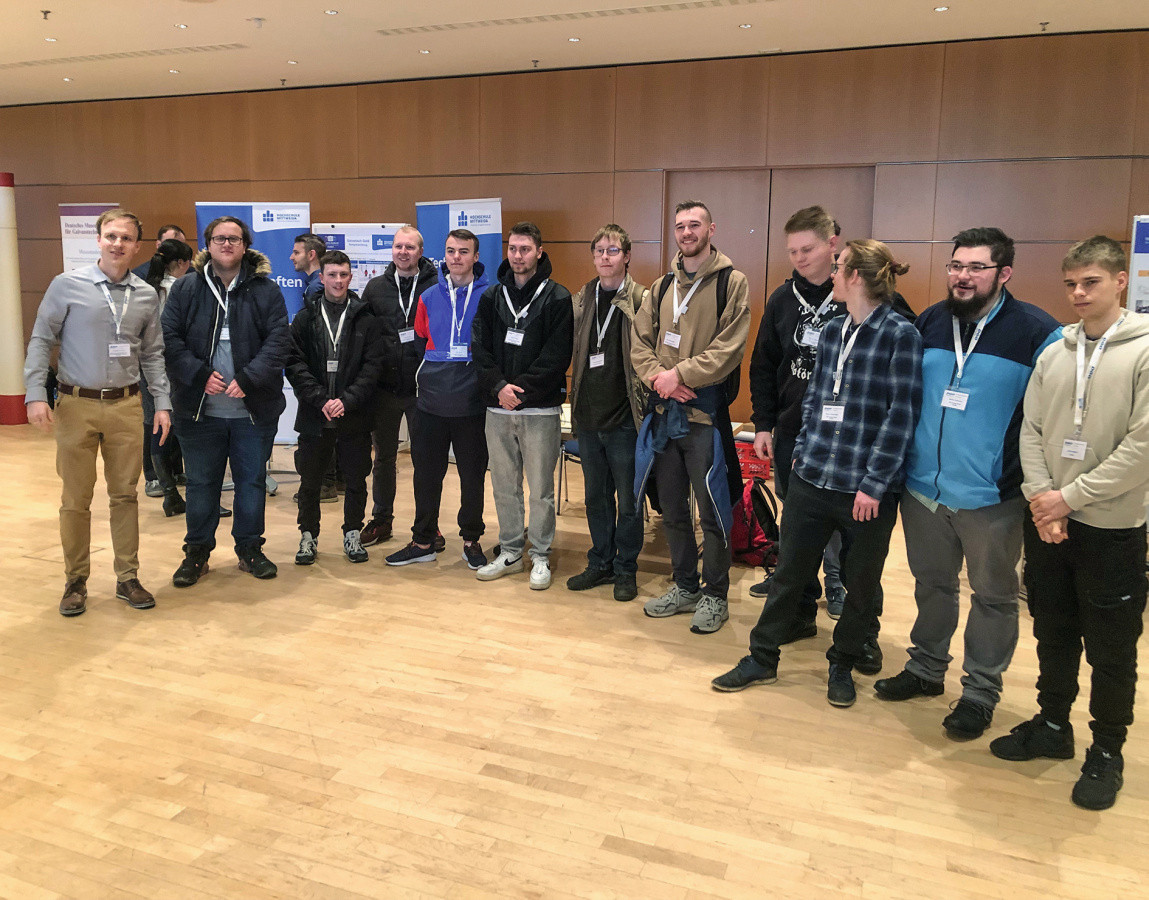 Surface technology trainees from the Zwickau vocational training center also came to Leipzig to learn about technologies and companies in the industry
Surface technology trainees from the Zwickau vocational training center also came to Leipzig to learn about technologies and companies in the industry
The coffee break was an invitation to visit the trade exhibition. Companies such as the plant manufacturer A. S. T., ICom Automation, Bi.Bra, as well as Georg Fischer Leipzig, Guschem and Mazurczak presented themselves here. A group of surface technician trainees from the Zwickau vocational training center also took the opportunity to get up close and personal with the industry. The Museum of Electroplating also had its own stand to draw attention to its range of products and services.
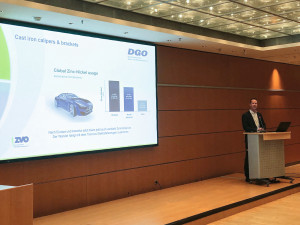 The presentation by René von Schaik from MacDermid Enthone Industrial Solutions in Langenfeld dealt with brake coating, especially for electric vehiclesAfterthe break, the presentation "Coating technologies for brake parts and outlook on future requirements" dealt with automotive coatings, another core topic in the industry. The speaker was René von Schaik from MacDermid Enthone Industrial Solutions in Langenfeld. Schaik emphasized that growth can be observed in zinc-nickel coatings for brakes because this coating can effectively prevent contact corrosion on aluminium. MacDermid Enthone Industrial Solutions offers additives and energy-saving auxiliary materials. The use of aluminum in cars is increasing noticeably. This also raises the question of coating. Schaik mentioned the anodizing of aluminium brake calipers and the so-called Castelox coating process for cast aluminium alloys. "The automotive industry and drive systems are changing," emphasized Schaik. The substrates to be coated today are predominantly aluminum and steels. In the subsequent round of questions, zinc-iron was also mentioned as a coating, which is apparently used in North America. However, Schaik objected that there are problems with the heat resistance of this coating.
The presentation by René von Schaik from MacDermid Enthone Industrial Solutions in Langenfeld dealt with brake coating, especially for electric vehiclesAfterthe break, the presentation "Coating technologies for brake parts and outlook on future requirements" dealt with automotive coatings, another core topic in the industry. The speaker was René von Schaik from MacDermid Enthone Industrial Solutions in Langenfeld. Schaik emphasized that growth can be observed in zinc-nickel coatings for brakes because this coating can effectively prevent contact corrosion on aluminium. MacDermid Enthone Industrial Solutions offers additives and energy-saving auxiliary materials. The use of aluminum in cars is increasing noticeably. This also raises the question of coating. Schaik mentioned the anodizing of aluminium brake calipers and the so-called Castelox coating process for cast aluminium alloys. "The automotive industry and drive systems are changing," emphasized Schaik. The substrates to be coated today are predominantly aluminum and steels. In the subsequent round of questions, zinc-iron was also mentioned as a coating, which is apparently used in North America. However, Schaik objected that there are problems with the heat resistance of this coating.
The subsequent presentation by Björn Stroh, Atotech MKS, dealt with the question "Pickling inhibitors - why weaken the pickling effect?". Stain inhibitors protect the base material from the "stain attack", but also reduce the risk of hydrogen diffusing into the crystal lattice of the base material and leading to hydrogen embrittlement, according to Stroh's comments on stain inhibitors, which are also produced and sold by his company.
The last speaker before the lunch break was Lukas Büscher from Munk GmbH. He presented state subsidies that companies can take advantage of when switching to more energy-efficient rectifiers. Using practical examples, he explained the successful implementation of funding measures (for more details, see the special feature on the Leipzig specialist seminar in Galvanotechnik 2/2023 on p. 202).
Afternoon program: Robotics application and borderline technologies
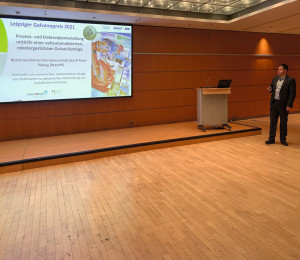 The afternoon program was moderated by technical expert Dr. Olaf Boehnke. The first speaker was Dr. Roy Morgenstern from the Chair of Materials and Surface Technology at Chemnitz University of Technology with his report on "Automated electrolyte development - possibilities and perspectives of robot-assisted electroplating". A consortium of his department, KleRO GmbH Roboterautomation and OTE Oberflächen- und Elektrotechnik Scheigenpflug GmbH received the Leipzig Electroplating Prize for this topic in 2021. Incidentally, this year's special feature was that no electroplating prize was awarded. No specific reasons were given for this. The core of the robot-assisted electroplating project is the resource-saving process and bath development in a fully automated electroplating process. In the lecture, Morgenstern presented the possibilities of this special electroplating system using an example of process development and research into the pulse parameter space for the deposition of ZnFe-Mo alloy layers as a REACh-compliant alternative to ZnNi.
The afternoon program was moderated by technical expert Dr. Olaf Boehnke. The first speaker was Dr. Roy Morgenstern from the Chair of Materials and Surface Technology at Chemnitz University of Technology with his report on "Automated electrolyte development - possibilities and perspectives of robot-assisted electroplating". A consortium of his department, KleRO GmbH Roboterautomation and OTE Oberflächen- und Elektrotechnik Scheigenpflug GmbH received the Leipzig Electroplating Prize for this topic in 2021. Incidentally, this year's special feature was that no electroplating prize was awarded. No specific reasons were given for this. The core of the robot-assisted electroplating project is the resource-saving process and bath development in a fully automated electroplating process. In the lecture, Morgenstern presented the possibilities of this special electroplating system using an example of process development and research into the pulse parameter space for the deposition of ZnFe-Mo alloy layers as a REACh-compliant alternative to ZnNi.
The last two presentations of the day dealt with frontier technologies in electroplating. Dr. Sven Gerullis, Innovent e. V., reported on investigations into the "Plasma treatment of dry lubricating powders and their incorporation into Ni dispersion layers to reduce wear". The results of the investigations showed that the mechanical and tribological properties of the Ni dispersion layers could be changed by incorporating the plasma-treated particles. All plasma-modified powder materials (hexagonal boron nitride hBN, polyether ether ketone PEEK, polyimide PI) could be incorporated into the Ni layers. The advantage of plasma modification over the previously used wet-chemical modification of non-dispersible substances is the absence of harmful surfactants.
The presentation by Julia Ullrich, Textile Research Institute Thuringia-Vogtland e. V., on the subject of "Galvanic meets textile" was eagerly awaited. She made it impressively clear what possibilities electroplating technology can offer and presented not only extremely interesting applications, but also the requirements for textile electroplating and showed possibilities for technical realization. Metallization can take place both on the textile surface and on the thread. The metallization of textiles is based on plastic metallization processes. However, the special properties of textile structures make it essential to adapt the process steps. In particular, pre-treatment, fabric guidance and electrolyte removal from the substrate pose major challenges. Further challenges are the adhesion of the applied metal layers, the textile processability and the preservation of textile properties. The 29th Leipzig Technical Seminar is scheduled to take place at the beginning of March 2024.

